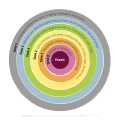Permaculture: Difference between revisions
Created page with "alt=Permaculture garden|thumb|'''Permaculture garden'''Permaculture, is a combination of the words permanent and agriculture, offers a uni..." Tag: visualeditor-wikitext |
CSV import Tags: mobile edit mobile web edit |
||
| Line 60: | Line 60: | ||
[[Category:Australian inventions]] | [[Category:Australian inventions]] | ||
[[Category:Environmental social science concepts]] | [[Category:Environmental social science concepts]] | ||
== Permaculture == | |||
<gallery> | |||
File:Permaculture_garden.JPG|Permaculture garden | |||
File:Franklin_Hiram_King.jpg|Franklin Hiram King | |||
File:Bill_Mollison_01.jpg|Bill Mollison | |||
File:Mycorrhizal_network.svg|Mycorrhizal network | |||
File:Ladybug_aphids.JPG|Ladybug and aphids | |||
File:Permaculture_Zones.svg|Permaculture Zones | |||
File:Sketch_of_Hugelkulture_bed_in_cross_section.jpg|Sketch of Hugelkultur bed in cross section | |||
File:Préparation_d'une_lasagne.jpg|Preparation of a lasagna bed | |||
</gallery> | |||
Latest revision as of 11:22, 25 February 2025

Permaculture, is a combination of the words permanent and agriculture, offers a unique approach to the practice of sustainable farming, ranching, gardening and living.
Concept[edit]
Permaculture shows how to observe the dynamics of natural ecosystems. We can apply this knowledge in designing constructed ecosystems that serve the needs of human populations without degrading our natural environment.
Symbiotic relationship[edit]
Permaculture sites integrate plants, animals, landscapes, structures and humans into symbiotic systems where the products of one element serve the needs of another.
Minimum outside materials[edit]
Once established, a permaculture system can be maintained using a minimum of materials, energy and labor.
Recycling waste[edit]
By recycling "waste" resources back into the system, it also minimizes pollution. It serves human needs efficiently by incorporating useful, high-yielding species.
Redundancy in the system[edit]
A permaculture system is designed to be diverse, so that even when one element fails, the system has enough stability and resilience to thrive. This gives it greater potential than a conventional system for long term economic stability.
History[edit]
Permaculture was developed in Australia in the late 1970’s by Bill Mollison and David Holmgren. It has since grown into an international grassroots movement.
Science and tradition[edit]
Permaculture is a unique blending of traditional practices and scientific knowledge, of ageless wisdom and innovative ideas, of time-tested strategies and useful information from around the world. Demonstration sites span the globe.
Permaculture systems[edit]
Permaculture systems have been established on every scale, from farms to apartments, from ranches to suburbs, in cities, gardens, schools and communities. They are proving successful in every climate, including the tropics, deserts, mountains and shores.
| This article is a stub. You can help WikiMD by registering to expand it. |
| Permaculture | ||||||||||
|---|---|---|---|---|---|---|---|---|---|---|
|
| Sustainability | ||||||||||
|---|---|---|---|---|---|---|---|---|---|---|
|
| Environmental social science | ||||||
|---|---|---|---|---|---|---|
|
| Simple living | ||||||||||
|---|---|---|---|---|---|---|---|---|---|---|
|
| Horticulture and gardening | ||||||||||
|---|---|---|---|---|---|---|---|---|---|---|
|
Permaculture[edit]
-
Permaculture garden
-
Franklin Hiram King
-
Bill Mollison
-
Mycorrhizal network
-
Ladybug and aphids
-
Permaculture Zones
-
Sketch of Hugelkultur bed in cross section
-
Preparation of a lasagna bed







